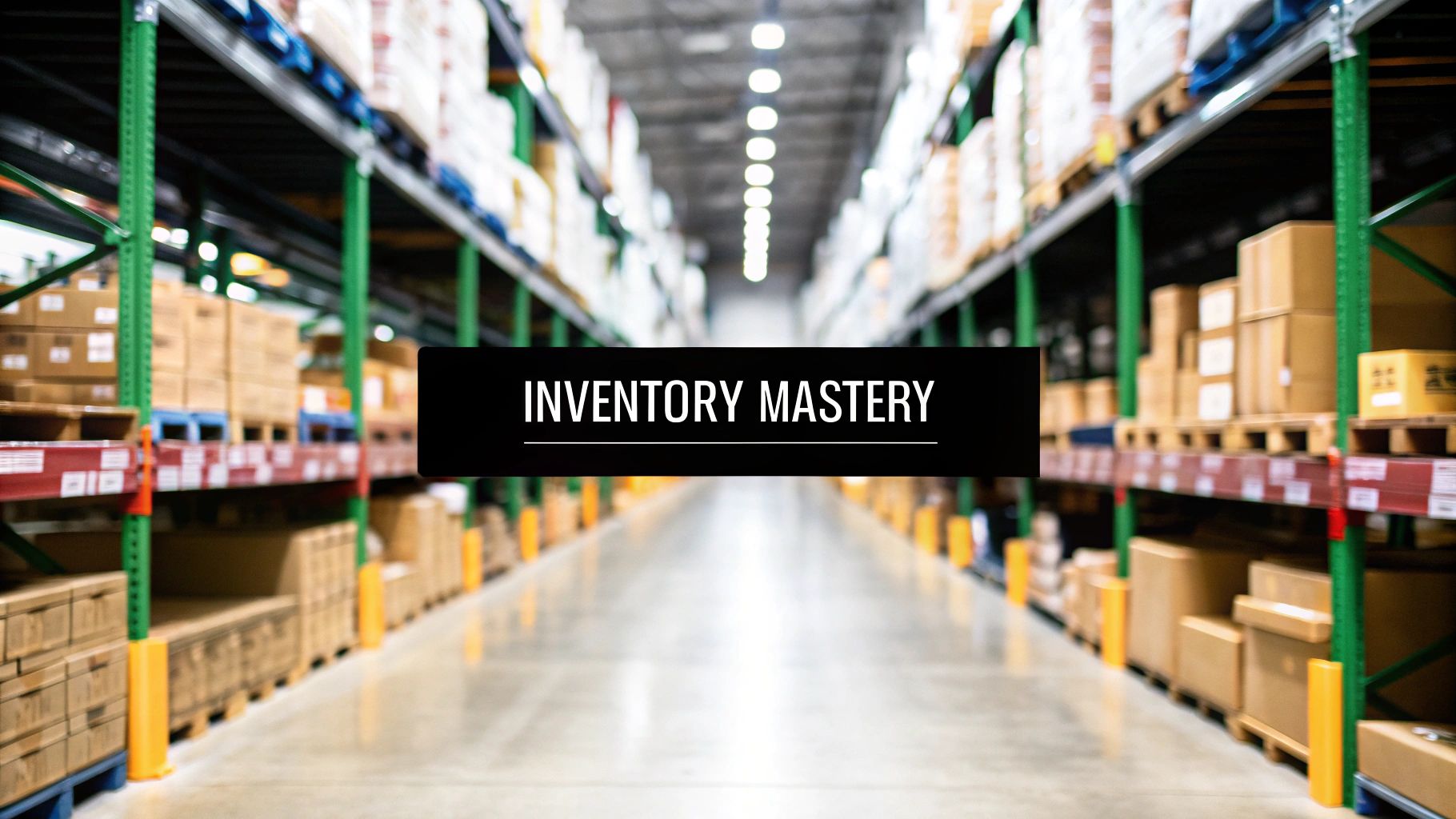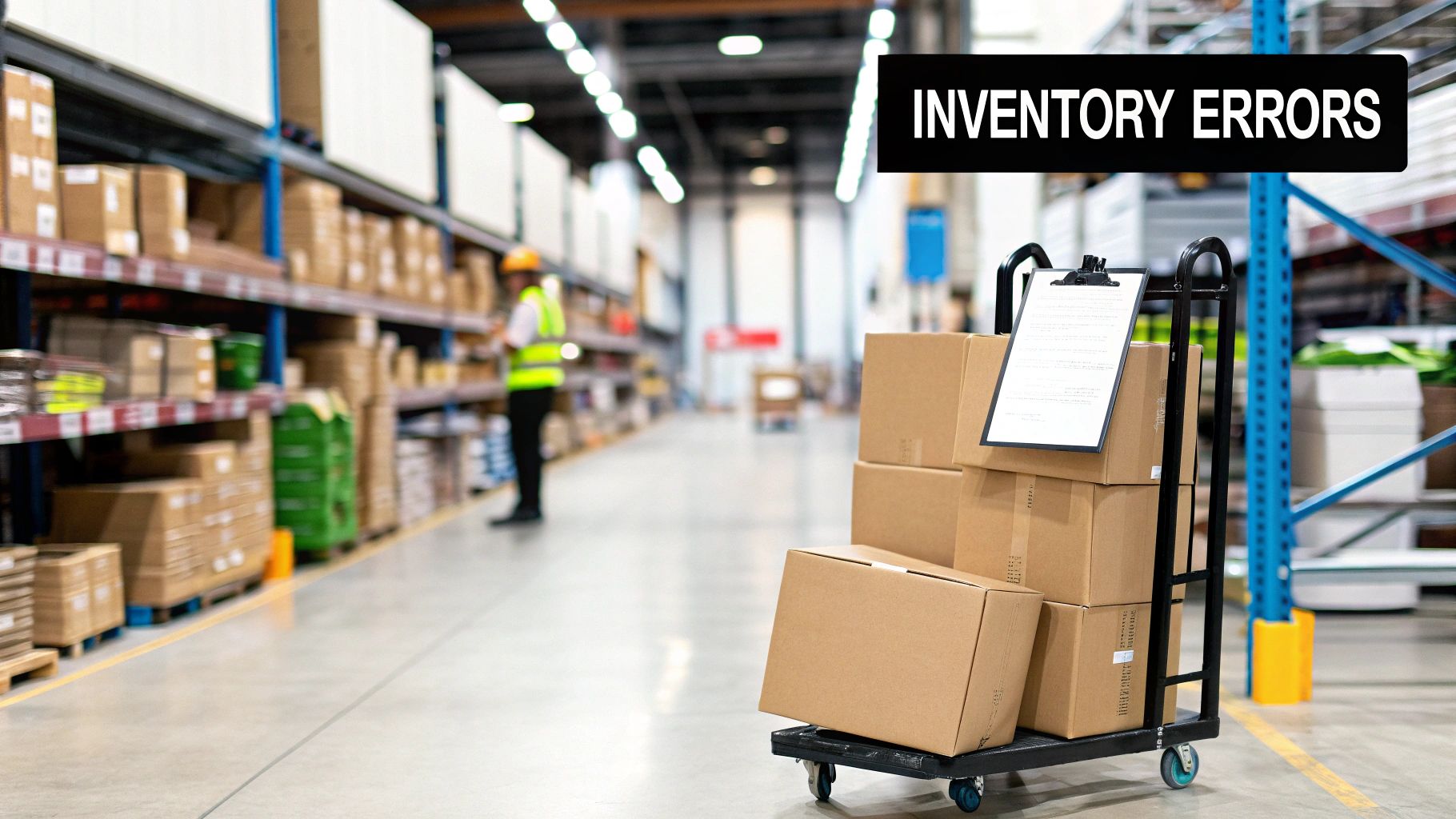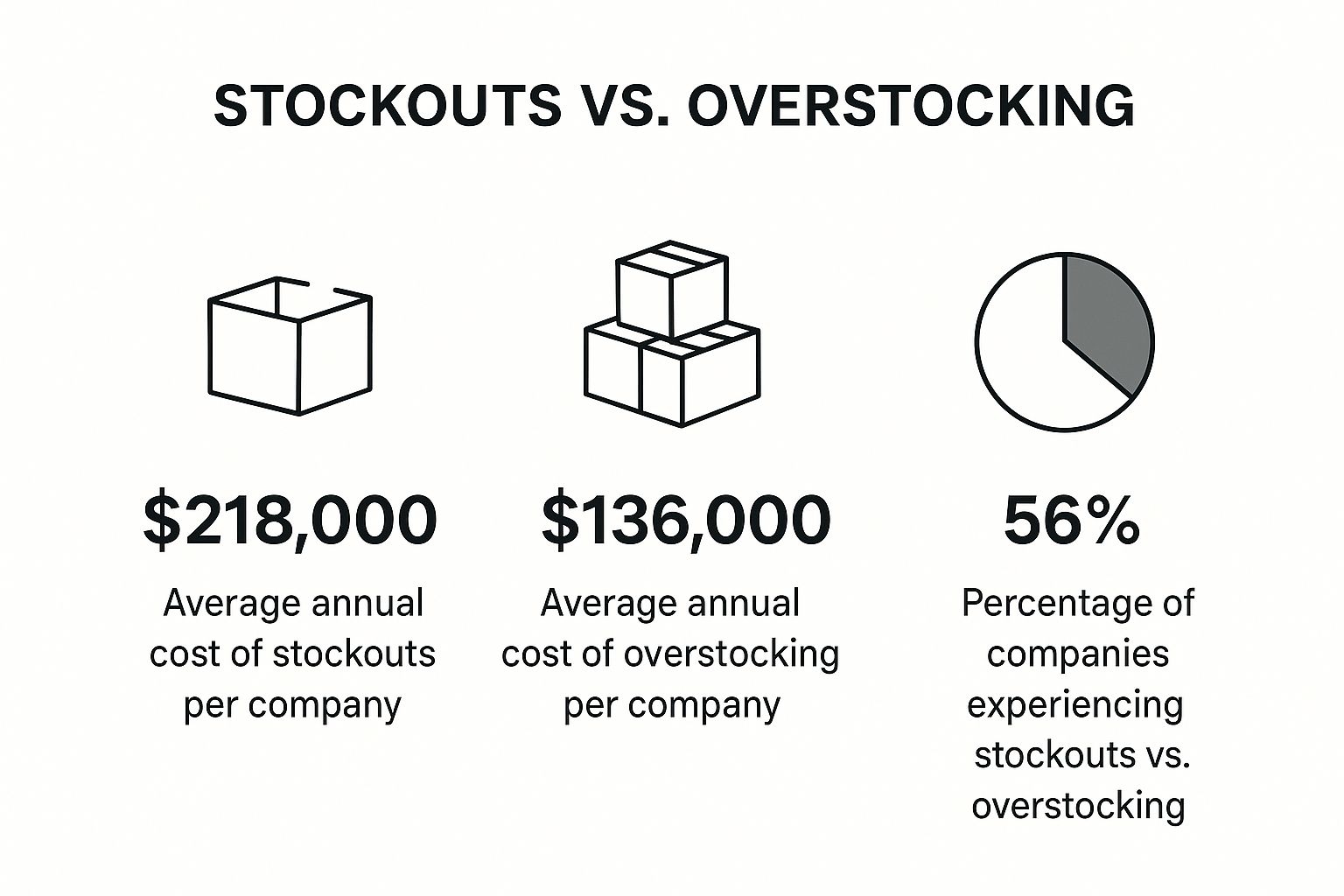Stay Updated with Everything about MDS
Thank you! Your submission has been received!
Oops! Something went wrong while submitting the form.

Chilat Doina
October 3, 2025
Let's be honest, wrestling with inventory can feel like you're constantly trying to plug leaks in a bucket. Every little misstep, from a surprise stockout to a misjudged forecast, slowly drains your profits. These aren't just minor operational headaches; they're genuine threats to your business's health.

Most of the frustration boils down to a few core problems that feed into each other, creating a cycle that's tough to break.
Inaccurate Forecasts: Trying to predict future demand without solid data is like navigating a ship in a storm without a compass. You’re bound to end up with a warehouse full of products nobody wants while your bestsellers are constantly out of stock.
The Overstock and Stockout Dilemma: This is the classic inventory trap. One side ties up your cash in dust-collecting products, racking up storage fees. The other side sends eager customers straight to your competitors when they can't find what they're looking for.
Poor Supply Chain Visibility: If you don't know where your inventory is at any given moment—whether it's on a truck, in a port, or sitting in a different warehouse—you're flying blind. This lack of clarity leads to costly delays, reactive decision-making, and a system that can't handle the slightest disruption.
It's easy to dismiss these as just "the cost of doing business," but the impact is massive and it ripples through your entire operation, directly hitting customer satisfaction and your bottom line.
The reality is that inventory distortion—the combined financial hit from shrinkage, stockouts, and overstock—costs retailers an estimated $1.1 trillion globally. That’s not a typo. It's a massive, avoidable expense.
Getting a handle on these specific pain points is the first step toward a healthier, more profitable business. Let's break down what each of these challenges really means and the damage they can do.
Here's a quick rundown of the most common inventory headaches and the real-world consequences they create for your business.
Understanding these connections is crucial. Once you can clearly diagnose the problem, you can start applying the right strategic fixes to stop the leaks for good.
Most major inventory headaches trace back to a single, critical failure: getting the forecast wrong. Think of demand forecasting as your business's weather report. A good one lets you prepare perfectly—stocking up on umbrellas right before a storm. A bad one? It leaves you with a warehouse full of sunglasses during a hurricane.
This isn't some dark art; it's a data-driven process that's surprisingly easy to derail. When your predictions miss the mark, the consequences ripple outward, creating the very overstock and stockout problems that bleed your profits. These forecasting errors aren't just bad luck—they’re often caused by predictable factors that businesses simply overlook.
The usual suspects behind forecasting errors are often hiding in plain sight. They paint a distorted picture of what customers will actually want, leading you to make expensive inventory bets based on flimsy assumptions.
Here are the key drivers of inaccurate forecasts:
Ignoring Seasonality: So many products have a natural rhythm. Selling winter coats, for example, follows a predictable annual cycle. If you fail to account for these peaks and valleys, you're guaranteed to have way too much stock in the off-season and not nearly enough when demand spikes.
Sudden Market Shifts: Consumer trends can turn on a dime. A viral social media post, a new competitor crashing the party, or an unexpected economic downturn can make your historical sales data irrelevant overnight. Relying only on past performance is like trying to drive forward while looking exclusively in the rearview mirror.
Relying on Outdated Data: Using old, stale data is one of the quickest ways to cook up a useless forecast. Customer behavior from two years ago—or even two months ago—might not reflect current buying habits at all. Solid forecasting needs a constant stream of fresh, relevant information.
Imagine a tech company launching a new smartphone. They base their production numbers on a successful model they launched two years prior. But they completely miss a new competitor's aggressive pricing and a general slowdown in the market.
The result? They produce 500,000 units but only manage to sell 200,000. Now they're sitting on a mountain of obsolete inventory with millions in capital tied up. This isn't a simple miscalculation; it's a massive strategic failure born from a bad forecast.
The goal is to move from reactive guessing to proactive prediction. Modern tools and strategies can flip your forecasting from a liability into a powerful competitive advantage. The focus shifts to building a system that actually anticipates what customers need, rather than just reacting to what they bought last quarter.
To build a more resilient forecast, you have to integrate more dynamic data sources and adopt smarter ways of analyzing it all.
A study found that improving forecast accuracy by just 10-20% can lead to a 5% reduction in inventory and a 2-3% bump in on-shelf availability. That's a direct line between better predictions and a healthier bottom line.
The first step is to get beyond simple historical averages. To really dig into building a more robust system, exploring different inventory forecasting methods is a great starting point. It gives you a structured way to analyze your data and pick the right model for your business.
The future of forecasting is all about using technology to see patterns the human eye would miss. This means embracing a much more sophisticated, data-rich approach.
Here are the key pieces of a modern forecasting strategy:
Predictive Analytics: This is where you use statistical algorithms and machine learning to figure out the likelihood of future outcomes based on historical data. Instead of just looking at what you sold last June, predictive models can analyze thousands of variables—like weather patterns, economic indicators, and promotional events—to generate a much more nuanced prediction.
AI-Driven Models: Artificial intelligence takes predictive analytics to the next level. AI models can continuously learn and adapt as new data pours in. They can spot subtle shifts in consumer behavior in real-time, tweaking forecasts on the fly to get more and more accurate over time.
Integrating Qualitative Data: Numbers alone don't tell the whole story. Bringing in qualitative data—like social media sentiment, customer reviews, and industry news—provides crucial context. If the online buzz for a product is exploding, a smart forecasting model will flag this as a potential demand surge, even if historical sales are flat.
When you combine these elements, you create a forecasting engine that doesn't just look backward. It looks forward, helping you make smarter purchasing decisions, keep your stock levels just right, and stay one step ahead of your customers.
Think of inventory management as walking a tightrope. Lean too far one way, and you’re drowning in overstock—your warehouse is packed, but your cash is tied up. Lean too far the other way, and you’re dealing with stockouts—customers are ready to buy, but your shelves are bare. Both scenarios are brutal, turning potential profits into painful losses.
Getting that balance right isn't just a logistical headache; it's a financial must-have for any business that wants to stick around. These twin problems are really just two sides of the same coin, and each one brings its own unique brand of chaos that goes way beyond a simple inventory miscount.
This infographic paints a pretty clear picture of just how much money businesses leave on the table when they get this balance wrong.

As the numbers show, both sides of the equation are costly. The instant financial gut punch from a stockout and the slow, creeping costs of overstock create a no-win situation for any business that can't find that sweet spot in the middle.
At first glance, having too much inventory might seem like a good problem to have. In reality, it’s a silent killer of profitability. Overstock isn't just unsold product; it's a constant, quiet drain on your resources that unleashes a wave of hidden costs.
Imagine every unsold item is a tiny anchor weighing down your business. One or two won't sink you. But let them pile up, and they'll grind your progress to a halt.
Overstocking isn’t just an inventory issue; it’s a capital issue. Every dollar tied up in a product that isn't selling is a dollar that can't be invested in growth, marketing, or high-demand products.
The biggest costs of having too much stock include:
This problem gets exponentially worse as you scale. The warehousing sector is a perfect example of these challenges, from handling unexpected demand surges to simply running out of room. By 2025, the global warehouse market is expected to hit about USD 869 billion, with around 180,000 warehouses worldwide. Even with all that space, the industry is plagued by inefficiencies like excess inventory and underused square footage.
While overstock is a slow, methodical bleed, a stockout is a sharp, immediate wound. The moment a customer is ready to buy and you don't have the product, the damage is done. And it's not just about one lost sale—you risk losing that customer forever.
The most obvious hit is lost revenue. That sale you were about to make? Gone. But the ripple effects are often far more destructive and harder to quantify.
The long-term consequences of stocking out are serious:
This is where managing your inventory across every channel becomes non-negotiable. For anyone selling on multiple websites or marketplaces, understanding the ins and outs of multi-channel inventory management is the key to keeping stock levels accurate and preventing the kind of stockouts that push customers away.
To really hammer home the importance of finding that balance, it helps to put the specific risks of overstock and stockouts side-by-side. Each one attacks your business from a different angle, from your balance sheet to your brand image.
At the end of the day, both overstocking and stockouts are symptoms of a deeper problem: a disconnect between what you have and what your customers want. Mastering the art of inventory balance isn't optional for any business serious about long-term health and profitability.

Let's be honest: trying to manage modern inventory often feels like you're navigating a maze completely blindfolded. Your products are scattered across a complex web of suppliers, containers, and warehouses, yet you have almost zero real-time information on where anything actually is.
This lack of supply chain visibility is one of the most crippling challenges businesses face. It turns what should be proactive planning into a constant, reactive scramble.
Without a clear view from end to end, you’re stuck making expensive decisions based on guesswork. You might rush to reorder an item that’s simply stuck at a port, not realizing it’s just a few days away from your warehouse. This kind of reactivity leads straight to bloated safety stock, costly emergency shipping fees, and unhappy customers wondering where their delivery is.
Modern supply chains are fragile. They’re intricate ecosystems that can be thrown completely off balance by a whole range of disruptions. Each one adds a new layer of uncertainty, making it that much harder to keep your stock at the right levels and deliver on your customer promises.
These aren't rare, once-a-year events anymore. They're the new normal.
When you can’t see what’s coming, you can't prepare for it. End-to-end visibility transforms your supply chain from a constant source of risk into a strategic asset that actually builds resilience and agility into your business.
To get a handle on all this complexity, you have to move beyond outdated spreadsheets and manual tracking. The only way forward is with technology that can shine a light into every dark corner of your supply chain, giving you a single, reliable source of truth. Improving your operational foundation is also key; you can dig deeper into some essential supply chain management best practices to help streamline these processes.
The fix for poor visibility is to build a connected, data-driven ecosystem. Modern tools are designed to cut through the fog by collecting and centralizing information from every single stage of your supply chain. This gives you the power to see exactly where your inventory is and where it’s headed—all in real time.
This move from an opaque system to a transparent one isn't just a minor upgrade. It’s a fundamental shift in how you manage your most important assets. One of the biggest inventory challenges today comes directly from the rapid growth of global supply networks, which demand a new generation of tools.
It's no surprise that the global inventory optimization market, valued at around USD 5.87 billion in 2025, is projected to more than double to USD 12.42 billion by 2032. This explosion is fueled by the desperate need for real-time analytics and cloud solutions that deliver the visibility everyone is chasing.
Achieving true end-to-end visibility isn’t about finding a single magic bullet. It’s about integrating a stack of technologies that work together to create a cohesive, transparent view of your entire operation. This is how you turn inventory management from a game of chance into a strategic, data-driven function.
Of course, gaining clarity also means optimizing your physical infrastructure. For some great insights into building efficient storage spaces, you might find resources like A Guide to Warehouse Steel Buildings helpful. By adopting these kinds of tools and strategies, you start building a resilient, agile operation that’s ready for whatever comes next.
A successful inventory strategy is never a one-size-fits-all blueprint. What works wonders in a mature European market could spell disaster in a rapidly emerging Asian economy. Adapting your approach for different regions is one of the toughest inventory management challenges out there, forcing you to turn a rigid playbook into a flexible, responsive system.
Think of it like this: you wouldn't use the same map to navigate Tokyo and a small rural town. Each location has its own unique roads, traffic patterns, and rules. In the same way, every market has its own logistical quirks, customer expectations, and regulatory headaches that demand a localized game plan.
A generic, cookie-cutter strategy completely misses these crucial differences. It fails to account for everything from local holidays that create massive demand spikes to regional infrastructure that causes frustrating shipping delays. The result? A costly and painful mismatch between what you have in stock and what's actually happening on the ground.
The real challenge is understanding that "global" is just a collection of many "locals." Each region throws a different set of operational curveballs that directly impact how you should manage your stock. Trying to ignore them is a recipe for inefficiency and lost sales.
Here are just a few of the regional factors you need to keep on your radar:
These variables show exactly why a centralized, top-down inventory plan so often falls apart. To win, you need decentralized intelligence and the agility to tailor your tactics to what's happening in each specific region.
This isn't just a theoretical problem—the market data backs it up. The global inventory landscape is anything but uniform, with different regions showing wildly different growth rates and facing their own unique hurdles.
A flexible, locally-informed inventory strategy is no longer a competitive advantage—it's a requirement for survival. Companies that cling to a single global model will consistently be outmaneuvered by more agile, regionally-aware competitors.
Data from 2021 to 2025 shows just how varied this landscape is. While some markets are stable, the Asia Pacific region is exploding and is set to become the largest growth driver, expected to command about 30.75% of the global market by 2025. This uneven growth is a direct result of distinct regional challenges, like infrastructure limitations and different rates of tech adoption. You can dig into the specifics by exploring the full analysis of the inventory management solutions market.
This data is crystal clear: you can't treat all markets the same. The strategies you need to capture growth in Asia are fundamentally different from what you need to simply maintain market share in North America or Europe.
Ultimately, overcoming global inventory management challenges means ditching the rigid, one-size-fits-all strategy. Instead, you need to build a resilient and intelligent system that actually listens to local signals. This means empowering your regional teams, using localized data for forecasting, and picking tech partners who get the nuances of each market you operate in. Get that right, and you can turn a complex global puzzle into a powerful, localized advantage.

Knowing the common inventory management challenges is one thing, but real change only happens when you start taking action. Think of this as your playbook for getting past the theory and putting proven inventory control techniques to work—the kind that delivers real, measurable results. It’s time to stop just reacting to inventory fires and start proactively managing your stock with a solid, disciplined game plan.
These strategies are all about bringing a bit of order to the chaos. They offer clear, actionable steps to help you finally get a firm grip on your stock levels. By adopting these methods, you'll systematically boost your accuracy, focus your team's efforts where they truly matter, and build a much more resilient and profitable business.
You can't have flawless inventory control if your data is a mess. It's that simple. If your system claims you have 50 units but there are only 30 sitting on the shelf, every single decision you make from that point on is built on a shaky foundation. The best way to fix this is to get a disciplined cycle counting program in place.
Forget the dreaded, disruptive, once-a-year physical inventory. Cycle counting is all about counting small, manageable portions of your inventory on a continuous basis. This approach dramatically improves your accuracy over time and doesn't bring your entire operation to a screeching halt.
A consistent cycle counting program can get you to 95% to 99% inventory accuracy. That's a level of precision that’s almost impossible to hit with annual counts alone, and it's the bedrock of any solid inventory management system.
Let's be honest—not all of your inventory is created equal. Some items are your superstars, the ones driving the bulk of your revenue. Others are slow-movers just collecting dust and taking up valuable space. ABC analysis is a killer method for sorting your inventory so you can pour your energy and cash where you'll get the biggest bang for your buck.
This technique buckets your products into three simple categories based on how much value they bring:
Putting this framework into action ensures your most critical assets get the VIP treatment they deserve. This optimizes your resources and helps prevent those gut-wrenching stockouts on your bestsellers.
Once your data is clean and your priorities are set, you can start using more advanced strategies to fine-tune your stock levels. Two of the most effective methods are setting intelligent safety stock levels and leaning into Just-In-Time (JIT) principles where they make sense.
Safety stock is that extra inventory you keep on hand to guard against stockouts caused by unexpected spikes in demand or supplier delays. Setting these levels is a real balancing act. Too little, and you risk empty shelves; too much, and you're just tying up cash in overstock. The trick is to use actual data on lead time and demand swings to calculate a buffer that protects you without bloating your warehouse.
Just-In-Time (JIT) inventory is a strategy where you receive goods from suppliers only when you need them for production or to fill an order. When you nail it, JIT can slash your holding costs and waste. While a full-blown JIT system can be tricky to implement, adopting its core ideas—like building better supplier relationships and shortening order lead times—can seriously lighten your inventory load.
A huge part of gaining this control comes from having the right tools. For example, implementing effective inventory management software can automate a ton of these processes, from tracking your cycle counts to suggesting optimal safety stock levels, making these powerful strategies accessible for any business.
When you're in the trenches managing stock, a lot of questions come up. It's only natural. Let's tackle some of the most common ones we hear from business owners trying to get a handle on their biggest inventory headaches.
Hands down, it's the lack of real-time visibility. This almost always comes from leaning too heavily on manual tools like spreadsheets. We’ve all been there, but those systems are not only a huge time sink, they’re also a breeding ground for human error.
This old-school approach forces you into a reactive mode, where you're constantly surprised by stockouts or finding cash tied up in products that just aren't moving. The best fix is to get on board with an affordable, scalable inventory management software early. Automating this piece of your business gives you the accurate, up-to-the-minute data you need to make smart, proactive decisions.
Think of it this way: technology takes forecasting from an educated guess to a data-driven science. Modern inventory systems use AI and machine learning to chew through massive amounts of data—your sales history, current market trends, seasonality, and even outside factors like a competitor’s big sale or economic shifts.
These aren't just fancy algorithms; they're designed to spot complex patterns a person could never hope to see. The result? Far more accurate and reliable predictions about what your customers will want to buy. The best part is that these machine learning models get smarter over time, constantly learning from new data to sharpen their own accuracy.
Choosing the right software really comes down to three things: what you actually need, whether it can grow with you, and how easy it is for your team to use.
Start with a list of your must-haves. Do you need to manage stock across multiple warehouses? Is barcode scanning critical? What about plugging directly into your e-commerce platform? Jot it all down.
Think about the future. Pick a solution that can scale up as your business grows. Making the right choice now saves you from a massive, expensive headache when you have to switch systems down the road.
Give it a test run. Finally, make sure the interface feels intuitive and that the company has a reputation for solid customer support. Shortlist two or three contenders and really dig into their free trials. There's no substitute for testing a platform in your own real-world environment to see how it truly fits your day-to-day workflow.
At Million Dollar Sellers, we know that dialing in your operations is what separates the good e-commerce businesses from the great ones. Our private community is for top entrepreneurs who want to share what’s working, get honest, behind-the-scenes insights, and scale their businesses smarter.
If you're a 7-, 8-, or 9-figure seller ready to connect with the best in the business, find out if you qualify to join MDS.
Join the Ecom Entrepreneur Community for Vetted 7-9 Figure Ecommerce Founders
Learn MoreYou may also like:
Learn more about our special events!
Check Events